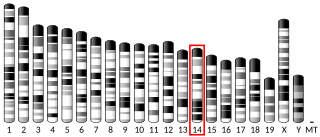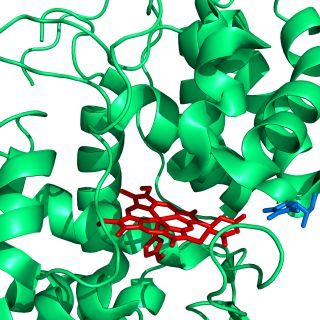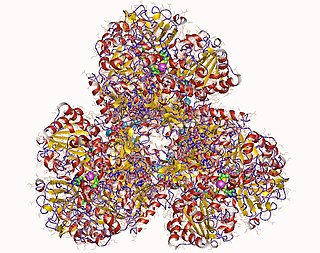
L-Gulonolactone oxidase is an enzyme that produces vitamin C, but is non-functional in Haplorrhini, in some bats, and in guinea pigs. It catalyzes the reaction of L-gulono-1,4-lactone with oxygen to form L-xylo-hex-3-gulonolactone (2-keto-gulono-γ-lactone) and hydrogen peroxide. It uses FAD as a cofactor. The L-xylo-hex-3-gulonolactone then converts to ascorbic acid spontaneously, without enzymatic action.

Ascorbate peroxidase (or L-ascorbate peroxidase, APX or APEX) (EC 1.11.1.11) is an enzyme that catalyzes the chemical reaction

In enzymology, a sulfite dehydrogenase (EC 1.8.2.1) is an enzyme that catalyzes the chemical reaction
In enzymology, a glucuronolactone reductase (EC 1.1.1.20) is an enzyme that catalyzes the chemical reaction
In enzymology, a L-arabinose 1-dehydrogenase (EC 1.1.1.46) is an enzyme that catalyzes the chemical reaction

In enzymology, a 3-dehydro-L-gulonate 2-dehydrogenase (EC 1.1.1.130) is an enzyme that catalyzes the chemical reaction:
In enzymology, a L-galactonolactone oxidase (EC 1.3.3.12) is an enzyme that catalyzes the chemical reaction
In enzymology, a Δ7-sterol 5(6)-desaturase is an enzyme that catalyzes the chemical reaction
In enzymology, a D-lactate dehydrogenase (cytochrome) is an enzyme that catalyzes the chemical reaction
In enzymology, a D-lactate dehydrogenase is an enzyme that catalyzes the chemical reaction
In enzymology, a carbon-monoxide dehydrogenase (cytochrome b-561) (EC 1.2.2.4) is an enzyme that catalyzes the chemical reaction

In enzymology, a formate dehydrogenase (cytochrome) (EC 1.2.2.1) is an enzyme that catalyzes the chemical reaction
In enzymology, a formate dehydrogenase (cytochrome-c-553) (EC 1.2.2.3) is an enzyme that catalyzes the chemical reaction

In enzymology, a L-ascorbate oxidase (EC 1.10.3.3) is an enzyme that catalyzes the chemical reaction
Germacrene A alcohol dehydrogenase (EC 1.1.1.314) is an enzyme with systematic name germacra-1(10),4,11(13)-trien-12-ol:NADP+ oxidoreductase. This enzyme catalyses the following chemical reaction
L-galactose 1-dehydrogenase (EC 1.1.1.316, L-GalDH, L-galactose dehydrogenase) is an enzyme with the systematic name L-galactose:NAD+ 1-oxidoreductase. This enzyme catalyses the following chemical reaction:
Polyvinyl alcohol dehydrogenase (cytochrome) (EC 1.1.2.6, PVA dehydrogenase, PVADH) is an enzyme with systematic name polyvinyl alcohol:ferricytochrome-c oxidoreductase. This enzyme catalyses the following chemical reaction
Hydroxylamine dehydrogenase (EC 1.7.2.6, HAO (ambiguous)) is an enzyme with systematic name hydroxylamine:ferricytochrome-c oxidoreductase. This enzyme catalyses the following chemical reaction

Nicotinate dehydrogenase (cytochrome) (EC 1.17.2.1, nicotinic acid hydroxylase, nicotinate hydroxylase) is an enzyme with systematic name nicotinate:cytochrome 6-oxidoreductase (hydroxylating). This enzyme catalyses the following chemical reaction
GDP-L-galactose phosphorylase is an enzyme with systematic name GDP:alpha-L-galactose 1-phosphate guanylyltransferase. This enzyme catalyses the following chemical reaction







